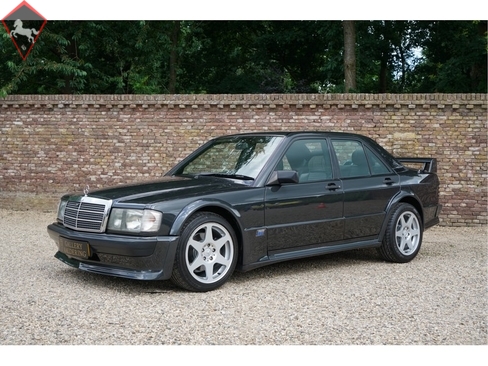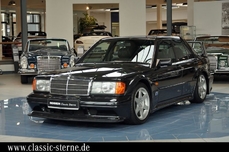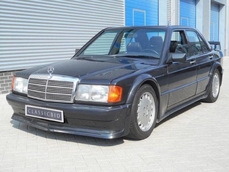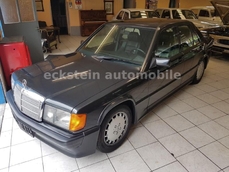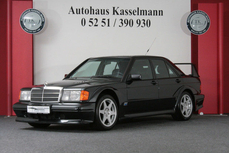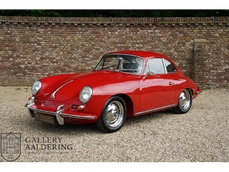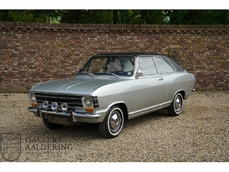Mercedes-Benz 190 2.5-16 1989
General description :
This is really special! Where are the good old times, when manufacturers were obliged to build homologation specials? In the late 80’s Mercedes-Benz participated in the Deutsche Toerenwagaen Meisterschaft (DTM). Before they could enter a new model they had to build and sell 500 with the same drivetrain, the so-called homologation specials. When BMW introduced the M3 Sport Evolution, Mercedes-Benz quickly realised they could no longer win with the “normal” 190E 2.5 16V. It was time for evolution. So the Mercedes-Benz 190 Evolution 1 was born. Mercedes-Benz developed a complete package of upgrades for the 190E Evo 1. Not every upgrade is obvious. The engine, brakes and suspension were totally overhauled. More obvious is the Evo 1’s exuberant but functional bodykit. This was old-fashioned tuning, unlike todays car that are called a limited edition after just adding a few stickers. No; every aspect of the car was attended to making it deserve its special title. The bodykit has a pair of sideskirts, a splitter and large rear wing. This is ultimate 80/90’s tuning. The engine delivered the same 205 amount of horse power as the regular 2.5 16V. This specific example has been fitted with the very rare AMG Power Pack. Only 16 Evo 1’s were fitted with this, then 16 thousand Deutsch Mark costing, package. The AMG Power Pack lifted the power output to 225 Hp, coincidentally the same as the later Evo 2 had. The increased power was achieved by sharper cam shafts, an enlarged throttle and different ignition. The combination of more power and a shorter locking differential made the 190E Evo 1 a seriously fast road going car. The Evo1 is so different to the regular 190E that Mercedes-Benz had to hand-build all 500 cars. Well with a hand-built Mercedes-Benz there are no points for guessing the high quality level of the car. Our example is still extremely sound and solid despite its high 440,000 km’s on the clock. It is probably the Evo 1 with the highest mileage in the world. Amazing! This just goes to show the standard of quality to which Mercedes-Benz kept in the past. The previous owner bought the car in 1997 when it had done 167,000 km. The engine is a completely overhauled exchange engine that is mounted at a mileage of 267,000 kilometers (documentation available).The documentation file shows that this Evo 1 has always been very neatly maintained. Furthermore a number of repairs have been carried out to keep the car up to scratch. The drivers seat has been re-upholstered and various body-parts have been re-sprayed in the original “Blauschwartz” finish. Externally there is evidence of use as one might expect with a car with this kind of mileage. This is not a 190E Evo 1 to keep under a blanket or one to win a concourse with. This 190E Evo 1 is made to drive, to attack your favourite twisty road with and to enjoy a by-gone era. If this car carried a medical information leaflet it would read; Use and enjoy! This Mercedes-Benz 190E Evolution comes with an extensive documentation file spanning 23 years. The original Evo 1 rims, original indicator and rear lights are included in the sale. You know that when you buy a near virginal mileage car, every additional mile will cost you 100’s if not 1000’s of euros in depreciation. You do not have to worry about that in this well used car. Who will continue this special Mercedes-Benz 190E Evo 1’s journey? Gallery Aaldering is Europe’s leading Classic Cars specialist since 1975! Always 300-350 Classic and Sportscars in stock, please visit http://www.gallery-aaldering.com for the current stock list (all offered cars are available in our showroom) and further information. We are located near the German border, 95 km from Düsseldorf and 90 km from Amsterdam. So easy traveling by plane, train, taxi and car. Transport and worldwide shipping can be arranged. No duties/import costs within Europe. We buy, sell and provide consignment sales (selling on behalf of the owner). We can arrange/provide registration/papers for our German (H-Kennzeichen, TÜV, Fahrzeugbrief, Wertgutachten usw.) and Benelux customers. Gallery Aaldering, Arnhemsestraat 47, 6971 AP Brummen, The Netherlands. Tel: 0031-575-564055. Quality, experience and transparency is what sets us apart. We look forward to welcoming you in our showroom
http://www.gallery-aaldering.com/mercedes-benz-190-e-evo-1-rare-homologations-special-only-500-made-en
1989 Mercedes-Benz 190 2.5-16 is listed sold on ClassicDigest in Brummen by Gallery Dealer for €49950.
Car Facts
Car type : Car Make : Mercedes-Benz Model : 190 2.5-16 Engine size : 0.0 Model Year : 1989 Sub type : Sedan Location : Brummen
Sold
Seller Information
Sold
People who viewed this Mercedes-Benz 190 2.5-16 also viewed similar Mercedes-Benz listed at ClassicDigest
Other cars listed for sale by this dealer
About Mercedes-Benz
In the annals of automotive history, the journey of Mercedes-Benz is a tale that unfolds with the ingenuity of its founding pioneers. In the year 1886, Karl Benz crafted the Benz Patent Motorwagen, a creation that would go down in history as the world's inaugural automobile. Unbeknownst to him, this moment marked the genesis of what would evolve into the most illustrious premium car manufacturer globally. The financial underpinning of this pioneering venture, interestingly, was provided by Karl Benz's wife, Bertha Benz, demonstrating a remarkable partnership that would set the tone for Mercedes-Benz's legacy.A parallel narrative emerged not far away, as Daimler-Motoren-Gesellschaft, founded by Gottlieb Daimler and Wilhelm Maybach, entered the scene. In 1901, they unveiled their automobile under the now-famous moniker "Mercedes," meaning "godsend" in Spanish. This name was bestowed upon the car at the behest of Emil Jellinek's daughter, the distributor for Daimler-Motoren-Gesellschaft. The wheels of innovation were set in motion.
Fast forward to 1926, a pivotal year that witnessed the merger of Daimler with Benz & Cie., culminating in the birth of Daimler-Benz. The amalgamation saw the adoption of "Mercedes-Benz" as the distinguished trademark for their automobiles, fusing the legacies of two visionary entities into one.
Contrary to perceptions of conservatism, the trajectory of Daimler-Benz unfolds as a chronicle of industry firsts. From the introduction of the honeycomb radiator to the float carburetor, and the pioneering implementation of four-wheel brakes in 1924, Daimler-Benz consistently pushed the boundaries of automotive innovation. The diesel-powered Mercedes-Benz 260 D in 1936 marked the inception of diesel engines in passenger cars. The iconic Mercedes-Benz 300SL Gullwing made history as the first car with direct fuel injection, albeit the Gutbrod's tiny 2-stroke engine can claim precedence.
Safety innovations became a hallmark, with Béla Barényi's patented safety cell design in the "Ponton"-models in 1951, featuring front and rear crumple zones. The W116 450SEL 6.9 saw the introduction of the Anti-Lock Brake system (ABS), another pioneering safety feature. From the first production airbags and beyond, the legacy of "firsts" continued to be etched into the fabric of Daimler-Benz.
Over its centennial journey, Mercedes-Benz has not merely produced cars but has sculpted automotive icons. The SSKL, 710 SSK Trossi Roadster, 770K Grosser, 540K Spezial Roadster, 300SL Gullwing, w100 600 Pullman, w111 280SE 3.5 Flachkühler, w113 230SL Pagoda, w109 300 SEL 6.3, and w201 2.3-16 Cosworth stand testament to the brand's commitment to engineering excellence.
The roaring Silver Arrows, or "Silberpfeile," including the W 25, W 125, W154, W165, and W196, created a legacy of dominance on the racetrack. These machines were not merely cars; they were expressions of precision, speed, and an indomitable spirit that left their competitors in the dust.
As Mercedes-Benz marches into the future, it does so not just as an automaker but as a custodian of a legacy, a torchbearer of innovation, and a beacon of automotive excellence. The road ahead is sure to witness the continued fusion of cutting-edge technology, timeless design, and an unwavering commitment to setting new standards in the world of automobiles.
One luminary figure who left an indelible mark was Béla Barényi, often heralded as the "father of passive safety" for his pioneering work in safety engineering. His patented safety cell design, featuring front and rear crumple zones, became a hallmark of Mercedes-Benz's commitment to occupant safety, setting new standards that reverberated throughout the automotive world.
Moving through the chronicles, the collaborative genius of Wilhelm Maybach, alongside Gottlieb Daimler, laid the foundation for Daimler-Motoren-Gesellschaft. Their innovations not only birthed the first Mercedes but established a culture of relentless pursuit of technological excellence that remains integral to Mercedes-Benz's DNA.
In the post-merger era of 1926, Ferdinand Porsche emerged as a prominent figure within Mercedes-Benz. His work on the Mercedes-Benz S-Type, a supercharged race car, garnered acclaim and set the stage for a legacy that extended far beyond the marque. Porsche's impact would later extend to his eponymous company, but his influence at Mercedes-Benz during those formative years was pivotal.
As the 20th century progressed, the legendary Rudolf Uhlenhaut emerged as a key figure. Uhlenhaut, an accomplished engineer and the driving force behind the iconic Silver Arrows, played a crucial role in Mercedes-Benz's dominance in motorsports. His engineering prowess and attention to detail were instrumental in creating some of the most formidable racing cars of the era.
In the latter half of the century, figures like Bruno Sacco, the head of design at Mercedes-Benz from 1975 to 1999, left an indelible imprint on the brand's aesthetic identity. Sacco's design philosophy, characterized by clean lines and timeless elegance, shaped iconic models like the W126 S-Class and the W201 190E, solidifying Mercedes-Benz's reputation for luxury and sophistication.
The narrative would be incomplete without acknowledging the contributions of engineers like Hans Scherenberg, whose leadership in the 1970s ushered in a new era of technological innovation at Mercedes-Benz. Scherenberg's tenure saw the development of groundbreaking technologies, including the Anti-Lock Brake system (ABS) and the introduction of airbags in production cars.
